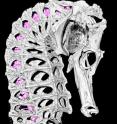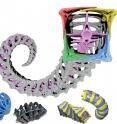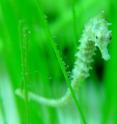Tough tail of a seahorse may provide robotic solutions
Related images
(click to enlarge)
One of the ocean's oddest little creatures, the seahorse, is providing inspiration for robotics researchers as they learn from nature how to build robots that have capabilities sometimes at odds with one another -- flexible, but also tough and strong. Their findings, published today in the journal Science, outline the virtues of the seahorse's unusual skeletal structure, including a tail in which a vertebral column is surrounded by square bony plates.
These systems may soon help create technology that offers new approaches to surgery, search and rescue missions or industrial applications.
Although technically a fish, the seahorse has a tail that through millions of years of evolution has largely lost the ability to assist the animal in swimming. Instead, it provides a strong, energy-efficient grasping mechanism to cling to things such as seaweed or coral reefs, waiting for food to float by that it can suck into its mouth.
At the same time, the square structure of its tail provides adequate flexibility, can bend and twist, and naturally returns to its former shape better than animals with cylindrical tails. This helps the seahorse hide, easily bide its time while food floats to it, and it provides excellent crushing resistance -- making the animal difficult for predators to eat.
"Human engineers tend to build things that are stiff so they can be controlled easily," said Ross Hatton, an assistant professor in the College of Engineering at Oregon State University, and a co-author on the study. "But nature makes things just strong enough not to break, and then flexible enough to do a wide range of tasks. That's why we can learn a lot from animals that will inspire the next generations of robotics."
Biological systems, Hatton said, can combine both control and flexibility, and researchers gravitated to the seahorse simply because it was so unusual. They theorized that the square structure of its tail, so rare in nature, must serve a purpose.
"We found that this square architecture provides adequate dexterity and a tough resistance to predators, but also that it tends to snap naturally back into place once it's been twisted and deformed," Hatton said. "This could be very useful for robotics applications that need to be strong, but also energy efficient and able to bend and twist in tight spaces."
Such applications, he said, might include laparoscopic surgery, in which a robotic device could offer enhanced control and flexibility as it enters a body, moves around organs and bones, and then has the strength to accomplish a surgical task. It could find uses in industrial system, search and rescue robots, or anything that needs to be both resilient and flexible.
The researchers were able to study the comparative merits of cylindrical and square structures by using computer models and three dimensional printed prototypes. They found that when a seahorse tail is crushed, the bony plates tend to slide past one another, act as an energy absorbing mechanism, and resist fracture of the vertebral column. They can then snap back to their normal position with little use of energy.
The square system also proved to be stiffer, stronger and more resilient than circular ones.
"Understanding the role of mechanics in these biologically inspired designs may help engineers to develop seahorse-inspired technologies for a wide variety of applications in robotics, defense systems or biomedicine," the researchers wrote in their conclusion.
Collaborators on this study included corresponding author Michael Porter from Clemson University; Ghent University in Belgium; and the University of California at San Diego. The work was supported by the National Science Foundation, the Air Force Office of Scientific Research, and the Agency for Innovation by Science and Technology.
Source: Oregon State University
Articles on the same topic
- Seahorse tails could inspire new generation of robotsThu, 2 Jul 2015, 19:34:07 UTC
- Why the seahorse's tail is squareThu, 2 Jul 2015, 19:33:44 UTC
Other sources
- Robot researchers say seahorse tails can inspire stronger botsfrom UPIFri, 3 Jul 2015, 14:00:15 UTC
- Sea horse's square tail could inspire future armored robotsfrom LA Times - ScienceFri, 3 Jul 2015, 0:30:25 UTC
- Seahorse's Square Tail Could Pump Up Robotic Armsfrom MSNBC: ScienceThu, 2 Jul 2015, 22:30:11 UTC
- Why the seahorse's tail is squarefrom Science DailyThu, 2 Jul 2015, 19:30:05 UTC
- Why seahorses have square tailsfrom Sciencenews.orgThu, 2 Jul 2015, 19:10:04 UTC
- Seahorse's Amazing Tail Could Inspire Better Robotsfrom Live ScienceThu, 2 Jul 2015, 18:30:29 UTC
- Why the seahorse's tail is squarefrom PhysorgThu, 2 Jul 2015, 18:00:56 UTC


